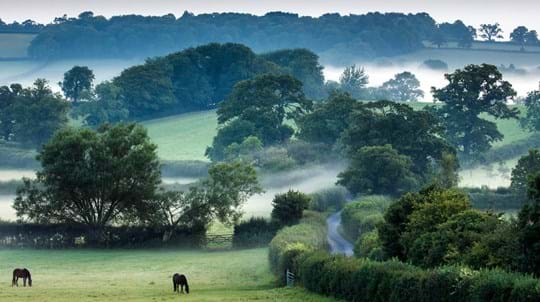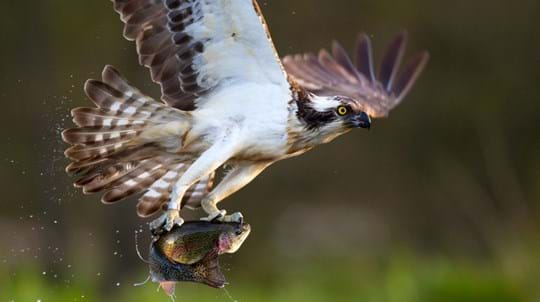
Climate change
Climate change
Our message is clear: native woods and trees are one of the best ways to tackle the climate crisis. Explore the facts and find out what you can do to help.

PR & communications officer - Scotland
Ospreys are found all around the world. A few populations stay in the same areas all year, but most have a winter home in the south and a summer home in the north where they breed. The journey is tough and dangerous. But evolution would not tolerate such risky behaviour unless there was a considerable upside. Here’s everything you need to know about osprey migration.
On migration, ospreys can fly over 400 kilometres in one day.
Although a few are now seen in Spain and Portugal, most British ospreys overwinter in West African countries like Senegal and The Gambia. They have quite an easy time of it there, in a pleasant climate with plenty of fish to eat.
Anglers often talk about ‘duffers’ fortnight’, a period in early summer when trout go mad for hatching flies and become easy for anglers to catch. This means they’re easy prey for ospreys too – and just when Dad is under most pressure to feed his new family. Handy!
Why don’t ospreys just nest in the south and skip the arduous 6,000km journey north? The main reason for migrating north is the long hours of daylight enjoyed there during summer. While nesting, the father hunts fish by sight to feed the whole family - longer daylight hours means more opportunity to catch enough food to go round.
Fewer predators will threaten eggs and flightless chicks in the north too. Scotland does not have cobras like Senegal!
Ospreys usually build their nests close to water for better access to the fish they eat, so another advantage for ospreys travelling to our Loch Arkaig Pine Forest in Scotland is a seasonal abundance of catchable trout in the loch. Insects such as mayflies, caddis flies, stoneflies and all sorts of midges, gnats and smuts live as larvae in the depth of the loch. In summer these rise to the surface, emerging into the air as adult flies ready to breed. Trout follow the insects towards the water’s surface, moving within range of diving ospreys which can only catch fish in the top metre or so of the loch.
The birds return to the south for the same reason - any osprey that stayed north would be unlikely to find enough fish to survive. As well as short winter days reducing available hunting time, the insect larvae move deeper in the loch, taking the trout with them – and the water may freeze over altogether.
It all depends on the weather, but generally ospreys arrive in the UK in late March to early April. They tend to head south again around September. The journey can take 4-6 weeks.
Chicks don’t learn to fish until they migrate and there are no lessons from the adults – they have to work it out themselves. Youngsters often break their trip at some favourable spot to hone their hunting skills before continuing their journey.
Ospreys often return to the same mate, but they migrate alone. At the end of each nesting season, the family bond breaks as each member of the osprey family departs one by one over a period of weeks.
The mother is first to leave, then the chicks set off one at a time and father leaves last. The birds will have no association with each other until the adults hopefully reunite at the nest to breed again the following year.
Climate change threatens this specialised lifestyle and its delicate relationships.
An osprey in West Africa contemplating a 45-day flight all the way to Scotland is relying on the behaviour of tiny midge larvae deep in Loch Arkaig to make it all worthwhile. But if warmer winter spells encourage insects to hatch earlier, there will be less of a bonanza in summer when osprey fathers need to bring fish to their new families.
More migrating birds could also perish if the weather gets rougher on their route.
Discover how trees can help fight climate change and what you can do to make a difference.

Climate change
Our message is clear: native woods and trees are one of the best ways to tackle the climate crisis. Explore the facts and find out what you can do to help.

Trees woods and wildlife
Trees are one of the best natural climate change solutions. Find out how they lock up carbon and how many the UK needs to reach carbon net zero by 2050.
Each year, after a successful breeding season, the ospreys we follow at Loch Arkaig Pine Forest begin their journey south.
Although resident pair Louis and Aila had been delighting viewers of our nest camera, supported by players of People’s Postcode Lottery, since 2017, only Louis returned in 2021. He paired up with a new female, Dorcha, at another tree in the forest, raising two chicks (Aspen and Alder) away from our camera. Once the birds had left for the year, we installed another camera at this new nest site, and captured Louis and Dorcha's second brood growing up in 2022. The rest, as they say, is history!

Discover what the ospreys are up to at Loch Arkaig right now and join the conversation.
Watch the osprey cam liveFind out more about the history of the Loch Arkaig ospreys, how we welcomed them to the pine forest, and how to tell them apart.

Trees woods and wildlife
No wi-fi, no plug sockets, no film crew. Meet the people behind the camera and explore the set of the UK's most remote family drama.

Blog
George Anderson • 05 Apr 2023

Our plans to restore the forest at Loch Arkaig are ambitious. And they will take time. But we can’t do it without your support.
Help protect the forest for wildlife